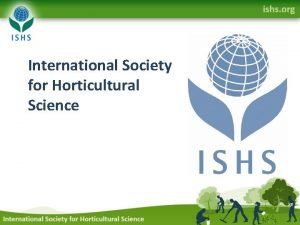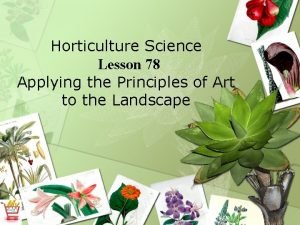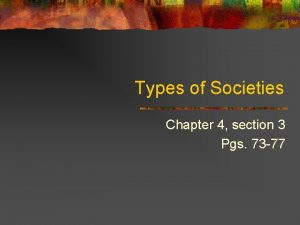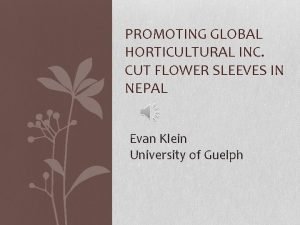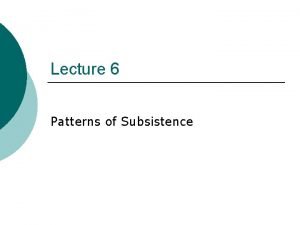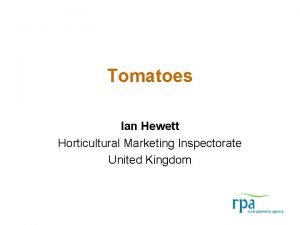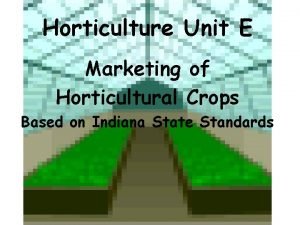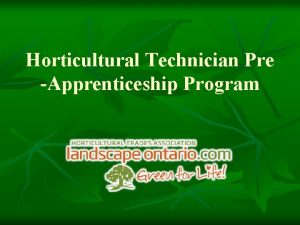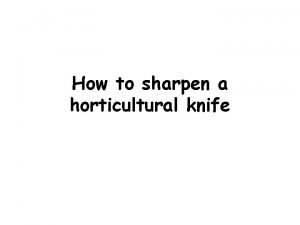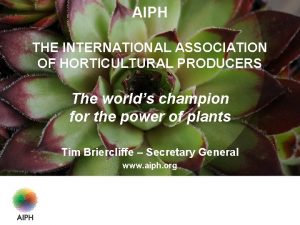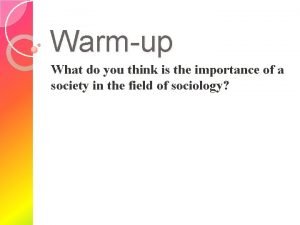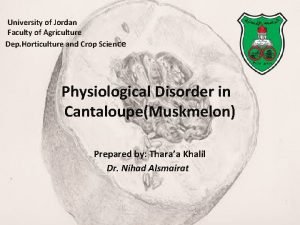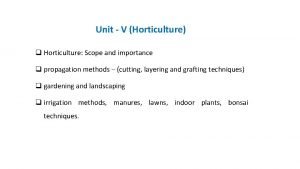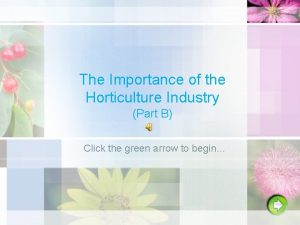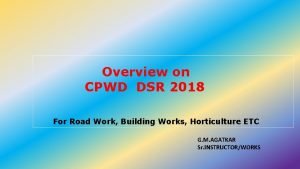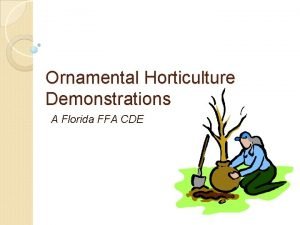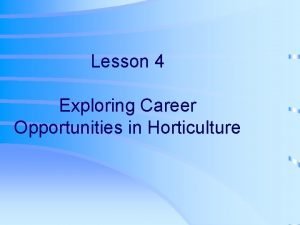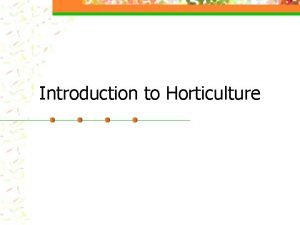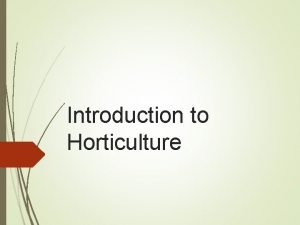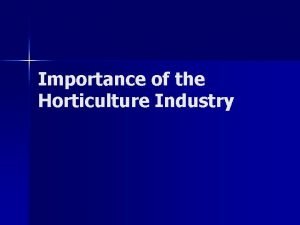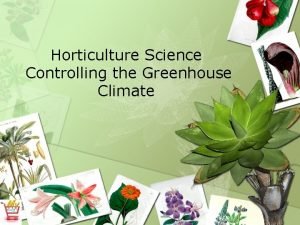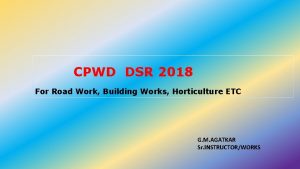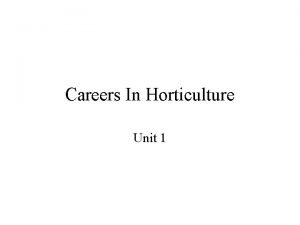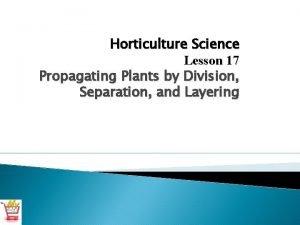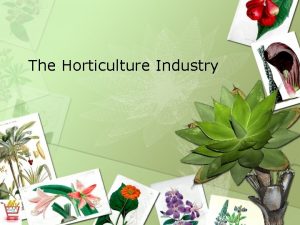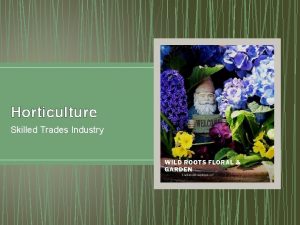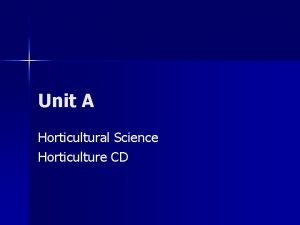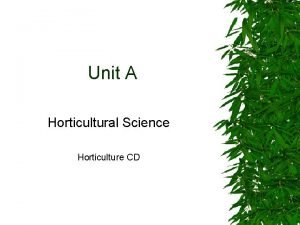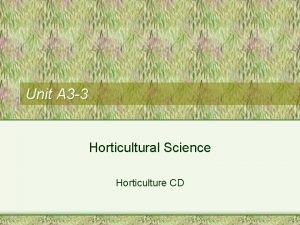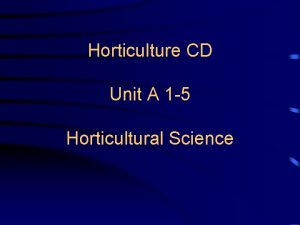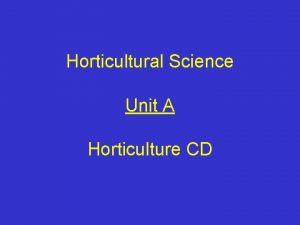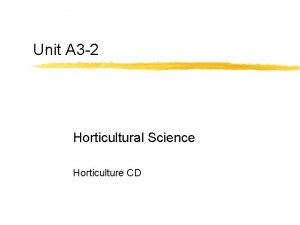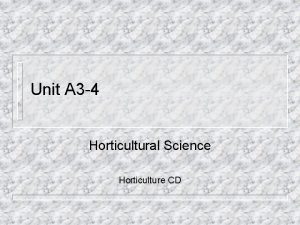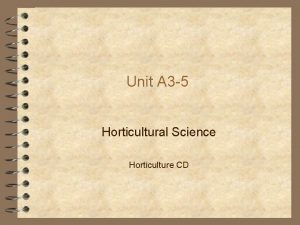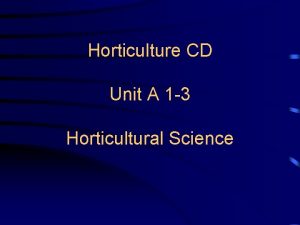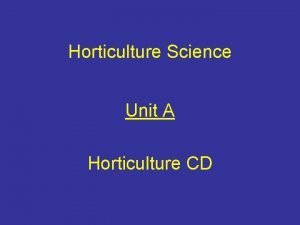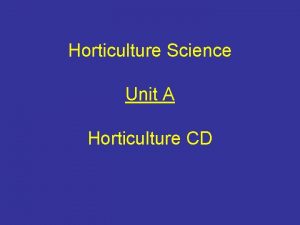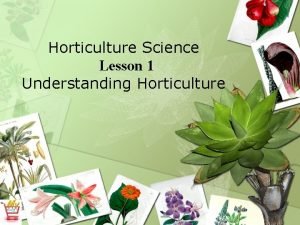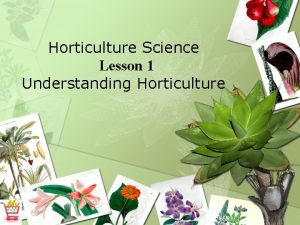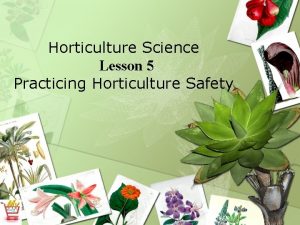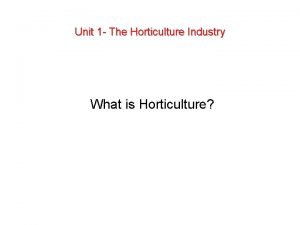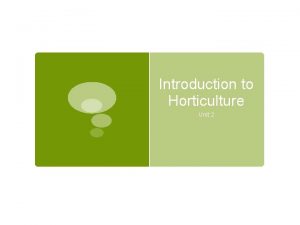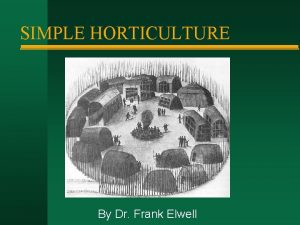Unit A 3 2 Horticultural Science Horticulture CD





























- Slides: 29

Unit A 3 -2 Horticultural Science Horticulture CD

Problem Area 3 Plant Propagation

Lesson 2 Propagating Plants Sexually

Interest Approach z Take a look at the variety of tulips below z Why is variety of great importance? z How do you get varieties in plants? z How has genetic variation impacted our world food resources? Courtesy of Breck’s

Vocabulary z Direct seeding z Dormant z Embryo plant z Germination z Hybrid z Indirect seeding z Medium z Planting date z Scarification z Seedling plant z Sexual reproduction z Stratification z Turgor z Viability z Vigor z Zygote

Student Objectives z 1. Discuss the importance of sexual propagation of plants z 2. Describe the process of seed germination z 3. Describe the factors involved in planting seeds for transplanting z 4. Explain how to successfully direct seed outdoors

How Does the Ability to Sexually Produce Seeds Benefit a Plant? z. Sexual reproduction in plants involves the union of the male pollen with the female egg and results in the formation of a seed y. This type of reproduction enables a plant to produce new combinations of genetic information that may add vigor to the developing young plant y. The seed is a living entity that serves as a bridge between generations of a plant

z. The embryo plant is a little plant that eventually grows and develops into a mature plant y. The embryo along with the endosperm (stored food) is inside the seed Embryo Seed x. It is protected by a seed coat from injury and dehydration until it is ready to germinate Seed coat Endosperm Courtesy of Corinne Banowski

z. The embryo plant within a seed is the result of a fertilized egg or zygote y. The zygote is the combination of genes from the male sperm and the female egg y. The plant resulting from this new combination of genes is known as a hybrid x. Horticultural crops have been greatly improved through hundreds of years of hybridization • Today’s crops have larger flowers, longer lasting flowers, and more flower colors than years ago

What Is Germination and What Conditions Are Necessary for Growth? z. When a seed is not growing, it is said to be dormant z. Germination is the process by which an embryo plant grows into a seedling y. It occurs at the end of the dormancy stage when conditions are favorable for plant growth y. The seedling plant has a root system, stem and leaves to produce food necessary for the young, actively growing plant

z. Many important crops are grown from seed y. Corn, cotton, bedding plants, vegetables, and many greenhouse crops y. A high percentage of germination is important Corn Cotton Courtesy of Mc. Graw Hill Publishers

z. Some plants produce seeds which germinate immediately, others produce seeds that remain dormant, perhaps for years, until the conditions are correct z. The optimal conditions needed for plant growth include proper temperature, moisture, light and oxygen

Germination Conditions z. The first important step in germination is usually the absorption of water y. Water enters the seed by osmosis x. It causes the seed to expand create pressure within the seed • This pressure is known as turgor and it causes the seed coat to rupture x. Through this split in the seed coat, the radicle or primary root will emerge and form the root system of the new plant

y. Water also stimulates the production of plant hormones that begin the process of digestion to provide energy for the embryo x. These hormones also cause mitosis (cell division) to occur • This produces the radicle in order to absorb more water and nutrients for the new plant z. Seeds of different species germinate at a range of temperatures from 320 F and 1040 F y. The optimum range for most plant seeds is between 650 to 800 F

z. All seeds need oxygen to germinate y. Oxygen is necessary for aerobic respiration that is required for the growth and development of the embryo y. It is important for the soil to not be too wet x. This will prevent oxygen from entering the soil which will result in the death of the embryo z. Seeds of some plants need exposure to light before they will germinate; Others do not

z. There are two additional mechanisms affecting germination in certain plant seeds: y. A) stratification – this process requires a period of cold temperatures x. It is especially important for plants that produce their fruit in the fall such as apples, pears, roses, and lilies • If their seeds immediately germinated, they will die from the cold winter temperatures • Instead, their seeds remain dormant until the warmer temperatures of spring

y. B) scarification – results from the breaking down of the seed coat x. Normally the tough protective coat prevents diffusion of both water & oxygen into the seed, so the coat needs to be broken x. Some seed coats are broken down by the stomach acid of an animal which eats the seeds x. Other methods of breaking the coat include continuous freezing & thawing, chewing, soil micro organisms, being stepped on, etc x. Examples of plants requiring scarification include geraniums, lupine, and canna

Scarification Methods Courtesy of Interstate Publishers

What Factors Are Necessary for Growing Plants Indoors? z. Seeds can be planted indoors until they grow into seedlings which are then transplanted into larger containers or their permanent growing areas y. This is known as indirect seeding y. Moisture, temperature, light and oxygen affect the growth of these plants indoors

z. It is important to start with a good quality seed; This will ensure that the desired plant will be produced y. It should be clean or free of dirt and weed seeds y. Seed quality also includes viability and vigor x. Viability = the ability of seeds to germinate under optimum conditions x. Vigor = the ability of seeds to germinate under different conditions and still produce healthy seedlings

z Seeds can be planted indoors to increase the length of the growing season, increase production and for economy of space y. They may be planted in flats or containers of germinating media x. Germinating medium is the material which is a source of nutrients and holds the roots in place for the growing plant Courtesy of Delmar Publishers

Steps in Planting Seeds Indoors z 1. Start with clean containers z 7. Maintain proper having drainage holes temperature. This is usually z 2. Fill with media & level it between 650 to 800 F z 3. Moisten the media so it is z 8. Water the seeds lightly damp but not soaked from the top using a sprayer or mister z 4. Plant the seeds according y Use warm not hot or cold to the depth on the package water z 5. Label the flat with the seed z 9. Cover the seeds with variety & date of sowing plastic or glass to maintain z 6. If using flats, sow the high humidity; remove it seeds in rows to reduce when the seeds germinate disease

Indirect Seeding Continued z The developing seedlings require higher amounts of oxygen, therefore, the media must be porous (having air spaces) z Avoid over-watering because this reduces the amount of oxygen available to the seedling z When the seedling has developed its first true leaves, it should be transplanted to a larger container y. Take care in handling the seedlings. They should be held by their leaves not the stem

Transplanting Process z Transplanting is a shock to the plant seedling and should be done soon after the first true leaves develop y 1. Make a hole in the new media with a dibble, stick, or forefinger and place the seedling in the hole at the depth slightly below the former depth y 2. Compress the media lightly around the roots and stem of the seedling y 3. Water and place the seedling in the shade to help prevent wilting y 4. After recovery, the seedling should be placed in proper lighting and watered to promote good health

What Factors Affect the Growth of Direct Seeded Plants? z. Many flowers, vegetables and grass seeds are planted directly into the soil outdoors in their permanent location y. This is known as direct seeding y. Factors that should be considered for this process include site selection, seed bed preparation, planting date, planting depth & spacing and care of the seedlings

Direct Seeding Factors z 1. The site should have sufficient light for the plants to grow y. Soil drainage is important and water should drain from the soil surface after a rainfall z 2. The soil needs to be loose, fine textured, and not compacted to allow for adequate moisture and aeration in seed germination and growth y. The beds should also be free of weeds that would compete with the seeds for oxygen, water and light z 3. The planting date is the date to plant seeds that is determined by the germination temperature required by the seeds

y. The date is also influenced by the time of maturity, harvest dates of vegetables and peak bloom dates of flowers z 4. Seeds should be sown at recommended planting depths and spacing y. A general rule, if the planting depth is unknown, is to plants seeds at a depth of three to four times their greatest thickness y. Some commercial crops require specific spacing x. Example, sweet corn is planted in rows 30” to 40” apart z 5. New seedlings will need a sufficient supply of water, oxygen and light y. It is also important to control weeds

Summary z How is sexual reproduction beneficial to plants? z What is another name for a fertilized egg? z Define hybrid. z When a seeds is not germinating, what stage is it in? z How is a seedling plant different from an embryo plant? z Define germination z What is turgor?

Summary Continued z. What factors affect the rate of germination? z. What is the difference between stratification and scarification? z. Contrast viability and vigor. z. Describe how to indirectly seed a plant. z. What factors affect the direct seeding of a plant?
 International society of horticulture science
International society of horticulture science International society of horticultural science
International society of horticultural science Applied principles of horticultural science
Applied principles of horticultural science Kinds of society
Kinds of society Papercut guelph
Papercut guelph Simple horticultural societies
Simple horticultural societies Jackfruit maturity indices
Jackfruit maturity indices Horticultural marketing inspectorate
Horticultural marketing inspectorate Marketing of horticultural crops
Marketing of horticultural crops Horticultural technician apprentice
Horticultural technician apprentice Horticultural knife
Horticultural knife International association of horticultural producers
International association of horticultural producers Characteristics of pastoral society
Characteristics of pastoral society Horticultural crops classification
Horticultural crops classification Favorite lesson in science
Favorite lesson in science Unit 6 review questions
Unit 6 review questions Dep horticulture
Dep horticulture Objectives of gardening
Objectives of gardening Importance of horticulture
Importance of horticulture Cpwd plinth area rates 2012
Cpwd plinth area rates 2012 Florida ffa cde
Florida ffa cde List of horticulture careers
List of horticulture careers Horticulture buyer jobs
Horticulture buyer jobs Horticulture word derived from
Horticulture word derived from History of horticulture
History of horticulture Advantages of horticulture
Advantages of horticulture Horticulture climate control
Horticulture climate control Dsr horticulture 2018
Dsr horticulture 2018 Objectives of gardening
Objectives of gardening What plant is it
What plant is it

